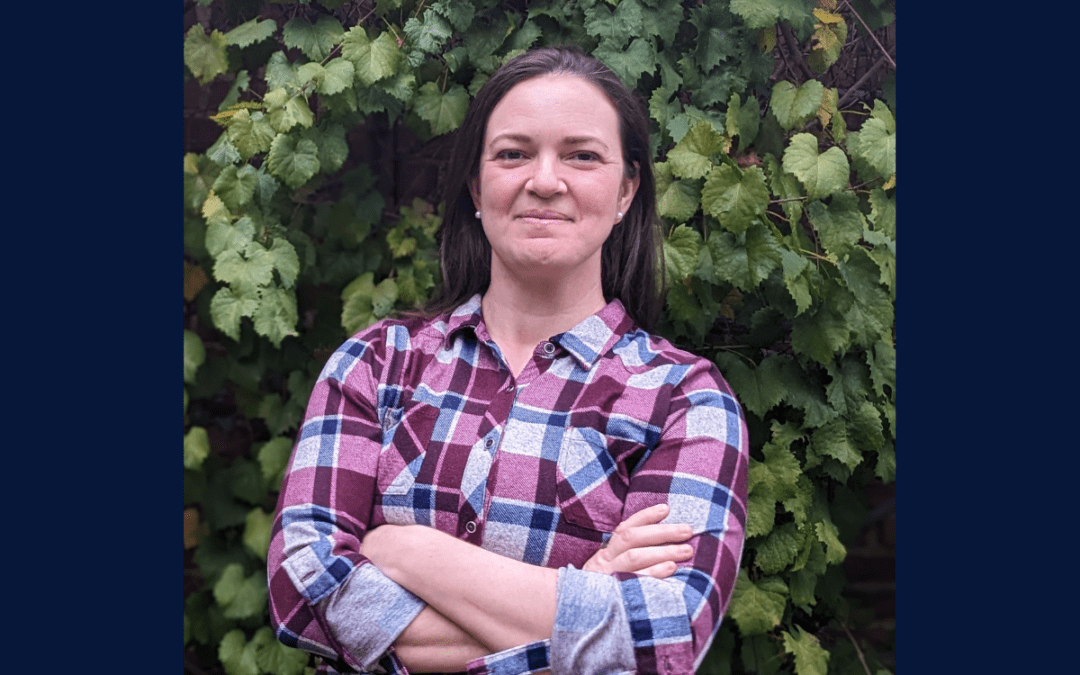
Federal funding helped Maysvile build a new public space on Main Street. It also helped it remove dangerous "forever chemicals" from its water supply. (Michael McElroy/Cardinal and Pine)
There was little federal guidance when Maysville’s water supply tested positive for dangerous ‘forever chemicals’ in 2019. So town officials acted on their own.
Soon after Schumata Brown was named town manager of Maysville, N.C. in 2016, he visited many of the town’s 1,000 residents, nearly all of whom he knew by name, and drank the water from their kitchen faucets.
Years earlier, aging infrastructure and cracked sewer lines in this small Eastern North Carolina town turned the water brown in many homes. Though the water had cleared by the time Brown took office, distrust remained.
So Brown, who was born and raised in Maysville, took single-use home testing kits door to door to assure his neighbors and new constituents that there were no longer any traces of lead or dangerous bacteria in the water supply.
The water, he told them, was safe.
Three years later, Brown had to return to his neighbors with less comforting news.
While Maysville’s water supply remained free of pathogens and metals, new testing in 2019 revealed huge levels of PFAS, the industrial ‘forever chemicals’ that have been linked to several serious health issues, including infertility, liver problems and cancer.
“For three years I preached to them, ‘your water is safe,’” Brown told Cardinal and Pine in January.
“Now I had to come out and tell them that we found chemicals in their water.”
But just like with the first water crisis, Maysville’s response to the new danger, along with some crucial funding from state leaders and the Biden administration, offers a blueprint for how government is supposed to work.
‘That was a no-brainer’
The EPA this month announced strict new rules for how utilities must address PFAS in their water, but in 2019, there was no guidance whatsoever.
Although Maysville had no legal requirements to do anything after its test results came back positive, Brown and other town officials didn’t hesitate.
When a second test confirmed the first, they shut off the town’s water supply and switched to Jones County water, which tested fine.
He’d read enough in those few days, he said, to know the risk.
“With good conscience and good grace to our citizens, that was a no brainer,” Brown said.
Shutting off the water, however, was only the first step. How would they get the PFAS out of Maysville’s water supply? Would they need to dig a new well? Buy a million dollar filtration system? Again, the guidance was limited. They sought and received state funding to start to deal with the problem, but it wasn’t enough.
They were on their own.
‘Those citizens can’t pay that’
In 2022, Brown and other local leaders applied for and received several rounds of federal funding through the Biden administration’s American Rescue Plan and Bipartisan Infrastructure Law to help clean and manage the water.
The money came in sips, but they were eventually able to pay for the installation of a new water filtration system that would eliminate all traces of the PFAS.
Maysville broke ground on the system in December. Brown said he expects it to be online sometime in May.
“You’re talking about a million dollar project, right? We got a thousand citizens, but we only have 450 water customers. Those citizens can’t pay that,” Brown said.
“Without that federal funding and state appropriation, we would have never been able to do that [filtration] project,” Brown said.
It took four years to get the filtration system, but health officials say that Maysville’s quick actions, the state and federal funding, and the Biden administration’s increased efforts to fight PFAS contamination were crucial to eventually solving a problem that has flummoxed communities small and large nationwide.

Schumata Brown, Maysville Town Manager, next to the town’s new PFAS-filtration system. (Michael McElroy/Cardinal and Pine)
What is PFAS?
PFAS is a class of man-made chemicals with a nearly unpronounceable name: per- and polyfluoroalkyl substances. They are called ‘forever chemicals’ because they can take thousands of years to break down naturally and accumulate in the body.
And they aren’t just forever, they are everywhere.
PFAS are used to make raincoats, non-stick cookware, water-proof boots, carpet, fire-fighting foam, pizza boxes, fast-food wrappers, umbrellas, camping gear, and lots of other things.
Researchers have linked PFAS exposure to decreased fertility, high cholesterol, thyroid conditions, some cancers, low birth weights, developmental delays, and pregnancy complications.
Recent studies show that more than 98% of people in the United States have at least some traces of PFAS in their bodies, and the chemicals have been found in at least half of all water supplies across the country.
‘I can’t go hide under a rock’
If you’ve driven from Raleigh to the coast, you’ve likely driven through Maysville. You just may not have realized it.
The town stretches for just over a mile on Highway 17 in the Eastern part of the state and is on the way to many of North Carolina’s most popular beaches. Driving the speed limit, it takes about two minutes to leave the town behind.
But Maysville, Brown said, was far more than a blur outside your car window as you go somewhere else.
The 2020 Census says that a little over 800 people live in Maysville, but Brown thinks that’s an undercount. He puts the population at more than 1,000. And he knows most of them.
“My grandfather, great-grandfather, mom, dad, uncles, brothers, sisters—they all stay here, all born and raised,” Brown said.
That familiarity affects how he governs, he said.
“Every decision behind this desk, it ain’t professional. It’s personal.”
And if he makes a bad decision that negatively affects his community, he’ll hear about it.
“I can’t go hide under a rock,” Brown said.
“I’m going to see those folks at the church. I’m going to see them at the grocery store, at the ball games. They’re going to come to my house.”
So when he learned of the newest threat to his town’s water, Brown immediately started reading all he could about PFAS chemicals, their sources and risks.
“There were a lot of late nights,” in the days between the initial and second tests, he said.
Brown had never heard of PFAS before 2019.
“I have a PhD in it now,” he said.
‘Everybody was caught off guard’
The PFAS testing was conducted by the North Carolina Collaboratory, a state-funded cooperative of North Carolina’s major colleges and universities to track and monitor environmental issues in the state. In 2018, the Collaboratory began to map the PFAS levels across public water lines and wells.
The next year, the testing came to Maysville.
Since there were no industrial polluters lurking upstream, Brown said, he figured they’d be fine.
According to the EPA’s drinking water standards at the time, PFAS levels of 70 parts per trillion were considered unsafe. Maysville’s levels came back at 103 parts per trillion.
“Everybody was caught off guard,” Brown said.
“How is this possible in Maysville?”
Though Brown was new to PFAS, he knew a few things already. He needed to communicate everything he’d learned to the community. Fast.
After they switched to the county water supply, town officials sent out a detailed press release, and held an emergency public meeting that night. They answered all the questions from the large crowd.
“I knew what this was going to create,” Brown said.
“It meant a whole lot to get it right.”
‘A million dollar problem’
There were a few things the town could do about the PFAS in its water. None of them were cheap.
A new filtration system designed for PFAS would cost over a million dollars.
Brown and other town officials moved fast to look for resources.
Maysville, working with the engineering firm that would build the new system, TRC, secured a $500,000 grant from the state then another $500,000 grant through the Biden Administration’s American Rescue Plan.
The funding was vital, Brown said, but it also reflected the slow, piecemeal progress that small towns with limited revenue have to settle for when facing problems that are bigger than they can solve on their own.
“Water is the quality of life,” he said. “We can live without a lot of things: Water’s not one of them.”
And what if previous town officials hadn’t thought to work with Jones County to connect their pipes long ago, just in case?
“We’d have been pumping that chemical [in Maysville’s water] for four years.”
A Bipartisan concern
In North Carolina, politics often floods policy, washing away cooperation and compromise. But on the issue of PFAS, most of the state’s leaders were in agreement.
North Carolina has been more responsive on the issue than most states, Jeff Warren, the executive director of the NC Collaboratory, said in an interview in February.
“It is a unique model to the nation. I’ve never seen anything like it in scope and magnitude,” Warren said.
Maysville’s surprise test results and quick response, Warren said, reflects the mission of the Collaboratory, Warren said, even if luck played its part too.
“There were a lot of planets in alignment [in Maysville],” Warren said, including the fact that they had a ready alternative in Jones County.
“There are going to be a lot of rural communities here that don’t have that option,” he said.
“But just looking at Maysville,” Warren said, “I think they did everything right.”
‘That’s all a lot of people want to see.’
Beyond the PFAS funding, state and federal grants have also helped Maysville revitalize the community, Brown said.
He applied for grants to build a new public arts and performance space, which are now up and running, and he will soon oversee the renovation of town hall and the fire station, which are in the same building. There are also plans to add some mixed-use buildings and rebuild some of Main Street’s empty and crumbling shops.
Through both the water crisis and new construction, the community-centered approach is crucial, Brown said.
“It gives your citizens confidence and it shows that you care,” Brown said. “It shows empathy. And that’s all a lot of people want to see.”
And if they don’t see it, he said, he knows that they know where to find him.
Politics

Opinion: My aunt died of an illegal abortion. We can’t go back.
When I was growing up, I was always closer to my mom. She was easier to talk to. Whenever I had a problem or was concerned about something, the...

Trump says he would allow red states to track pregnancies, prosecute abortion ban violators
In an interview published by Time magazine this week, former president Donald Trump detailed his plans for a potential second term and said he would...
Local News

Does NC have more serial women poisoners than anywhere else? Getting to know NC true crime writer Cathy Pickens
Charlotte's Cathy Pickens is the NC author of the Blue Ridge Mountain Mysteries, a local true crime series. We had some burning questions for her....

NASA astronaut Christina Koch receives highest NC honor
Gov. Cooper honored NASA astronaut and North Carolina native Christina Koch while highlighting the state’s strong public schools. At a recent event,...





